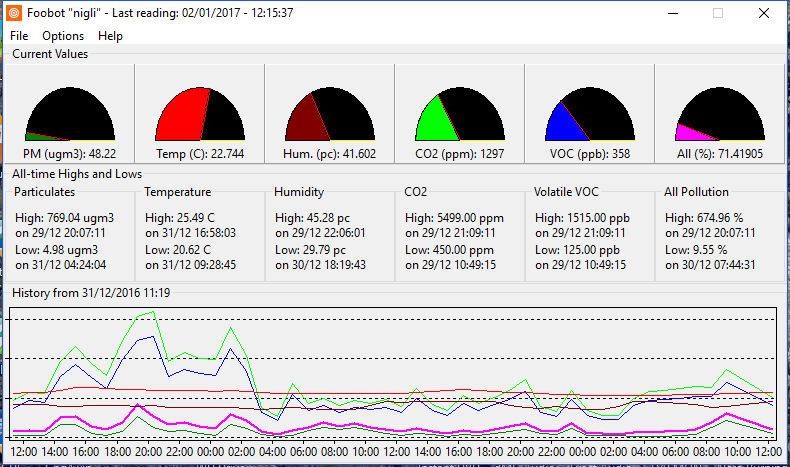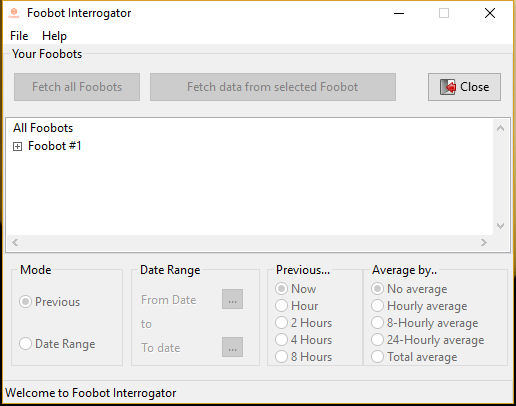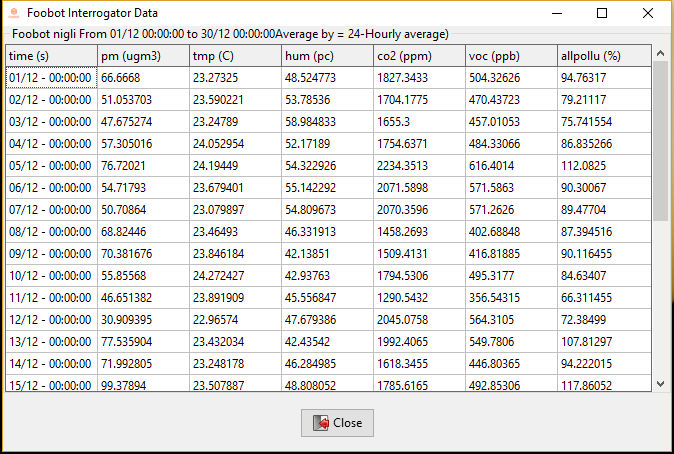Difference between revisions of "Foobot"
Minesadorada (talk | contribs) m |
Minesadorada (talk | contribs) (Added config file editing) |
||
| Line 44: | Line 44: | ||
function FoobotDataObjectToArrays: boolean; | function FoobotDataObjectToArrays: boolean; | ||
</syntaxhighlight> | </syntaxhighlight> | ||
| + | ===Security=== | ||
| + | * When first run Foobot Monitor will prompt you to enter your Foobot Username, Password and an API Key. | ||
| + | * These values are then stored in an encrypted configuration file so that they will load automatically in future | ||
| + | * The configurarion file is located: | ||
| + | ** Windows: %APPDATA%\username\Local\foobotmonitor\ | ||
| + | ** Linux /etc/.foobotmonitor | ||
| + | * You can alter/update the stored login data in the following way: | ||
| + | 1. Open the foobotmonitor.cfg file<br> | ||
| + | 2. Make a new entry thus, then save the file. (using your values instead of the example <..> ones) | ||
| + | <syntaxhighlight> | ||
| + | [Config] | ||
| + | Foobot User=<username> | ||
| + | Secret Key=<Secret API Key> | ||
| + | </syntaxhighlight> | ||
| + | * Next time Foobot Monitor is run, these values are read, then encrypted and the plaintext is deleted | ||
| + | ** You can do this as many times as you like | ||
===Licence=== | ===Licence=== | ||
| − | License is | + | License is GPLV2 (https://en.wikipedia.org/wiki/GNU_General_Public_License) |
[[User:Minesadorada|Minesadorada]] | [[User:Minesadorada|Minesadorada]] | ||
[[Category:Applications_created_with_Lazarus]] | [[Category:Applications_created_with_Lazarus]] | ||
Revision as of 18:08, 30 December 2016
Lazarus and the Foobot air quality monitor
- Foobot(http://foobot.io/) is an InternetOfThings gadget that monitors indoor air quality.
- Unfortunately, the company only supplies mobile phone apps to access the Foobot.
- They do however publish an API which returns JSON data when queried, so I decided to port it to the PC using Lazarus and FPC
- The API page is here: https://api.foobot.io/apidoc/index.html
Screenshots
- Foobot Monitor
- Foobot Interrogator
What you will need
1. A Foobot
2. A Foobot account
3. A free API Key (get one from the API page: https://api.foobot.io/apidoc/index.html)
Binary Downloads: Foobot Monitor
Windows 32/64 binaries:
https://svn.code.sf.net/p/lazarus-ccr/svn/applications/foobot/monitor/innosetup/setup_foobotmonitor.exe
Linux 32/64 binaries:
https://svn.code.sf.net/p/lazarus-ccr/svn/applications/foobot/monitor/linuxbinaries/foobotmonitor.zip
Binary Downloads: Foobot Interrogator
Windows 32/64 binaries:
https://svn.code.sf.net/p/lazarus-ccr/svn/applications/foobot/innosetup/foobotinterrogator_setup.exe
Linux 32/64 binaries:
https://svn.code.sf.net/p/lazarus-ccr/svn/applications/foobot/compiled/linuxbinaries.zip)
Source
Source code is in Lazarus CCR here: https://svn.code.sf.net/p/lazarus-ccr/svn/applications/foobot/
Functions
There are two main functions in foobot_utility.pas for you to use. Both will populate TObjects in foobot_objects.pas which you can read.
// Populates FoobotIdentityObject.TFoobotIdentityList collection
function FetchFoobotIdentity(aUsername, aSecretKey: string): boolean;
// Populates FoobotDataObject
function FetchFoobotData(DataFetchType: TDataFetchType = dfLast;
iCurrentFoobot: integer = 0; iLastIntervalSeconds: integer = 3600;
iLastAverageBySeconds: integer = 0; iStartTimeSeconds: int64 = 0;
iEndTimeSeconds: int64 = 0; aSecretKey: string = 'unknown'): boolean;
// Populates datapoint arrays from FoobotIdentityObject for easy access
// - also populates HighLow arrays
function FoobotDataObjectToArrays: boolean;Security
- When first run Foobot Monitor will prompt you to enter your Foobot Username, Password and an API Key.
- These values are then stored in an encrypted configuration file so that they will load automatically in future
- The configurarion file is located:
- Windows: %APPDATA%\username\Local\foobotmonitor\
- Linux /etc/.foobotmonitor
- You can alter/update the stored login data in the following way:
1. Open the foobotmonitor.cfg file
2. Make a new entry thus, then save the file. (using your values instead of the example <..> ones)
[Config]
Foobot User=<username>
Secret Key=<Secret API Key>- Next time Foobot Monitor is run, these values are read, then encrypted and the plaintext is deleted
- You can do this as many times as you like
Licence
License is GPLV2 (https://en.wikipedia.org/wiki/GNU_General_Public_License)


